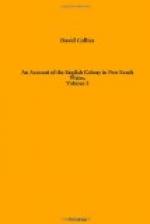On the eastern side, the hills being neither steep nor prominent, some extensive slopes of tolerably good, though sandy soil, have been formed. Several which extended to the water, being well covered with grass and thinly set with timber, had a pleasing appearance from the bay, and resembled some of the most beautiful parts of Mount Edgecumbe, near Plymouth. Speaking generally of the land round the bay, it might be said to be much more barren that productive; that there are several patches of tolerably good, and some few of excellent soil; but by far the greater part is incapable of cultivation, and fit only for pasturage.
The most common timber is a sort of gum tree, the bark of which along the trunk is that of the iron bark of Port Jackson; and its leaf, that of the blue gum tree; but its branches toward the head are of a yellow colour, smooth, and resembling the barked limbs of trees. The wood is longer grained, and more tough, splitting easier and more true than any other species of the gum tree.
The natives are, in person, similar to those living about Port Jackson, but their language was perfectly unintelligible. They used canoes, of which they seemed very careful; for on his rowing round the point of Snug Cove, when Mr. Bass was on his first visit to this bay in the whale boat, a party of them paddled hastily on shore, taking their canoes upon their heads, and running off with them into the woods. They, however, did not appear so shy of their visitors now as they had formerly been; and there was reason to believe that a friendly intercourse might have been easily established with them.
Not meeting with any grass trees, and the few spears that were seen being made of solid wood, it may be conjectured that the light grass reed spear used by the natives of Port Jackson is unknown among these people, as well as the use of the throwing-stick.
But very few marks of the kangaroo were seen. Both quadrupeds and birds appeared to be less numerous here than in other places. The dogs found a porcupine ant-eaters, but they could make no impression on him; he escaped from them by burrowing in the loose sand, not head foremost, but sinking himself directly downwards, and presenting his prickly back opposed to his adversaries.
There were a few ducks, teal, herons, cranes, and a bird named from its bill the Red-bill, upon the lagoons, with some small flights of curlew and plover of a beautiful feather.
The rocks consist of hardened clay, in which are mixed great numbers of small stones, variously tinged, some with red, others with yellow. Small portions of calcareous spar lie scattered about the surface of the rocky ground; strata of which are deposited irregularly in fissures formed in the body of the rocks themselves.




